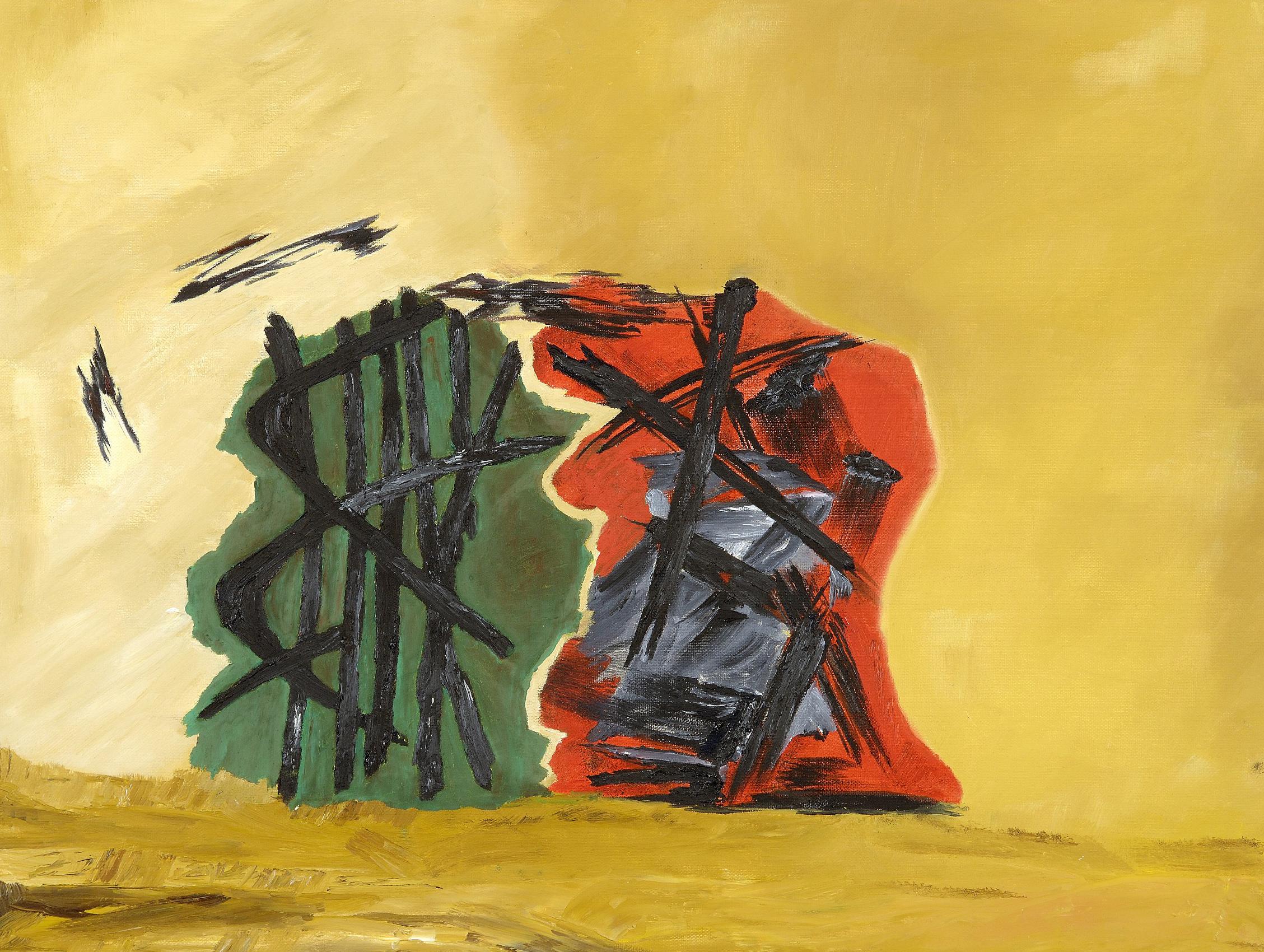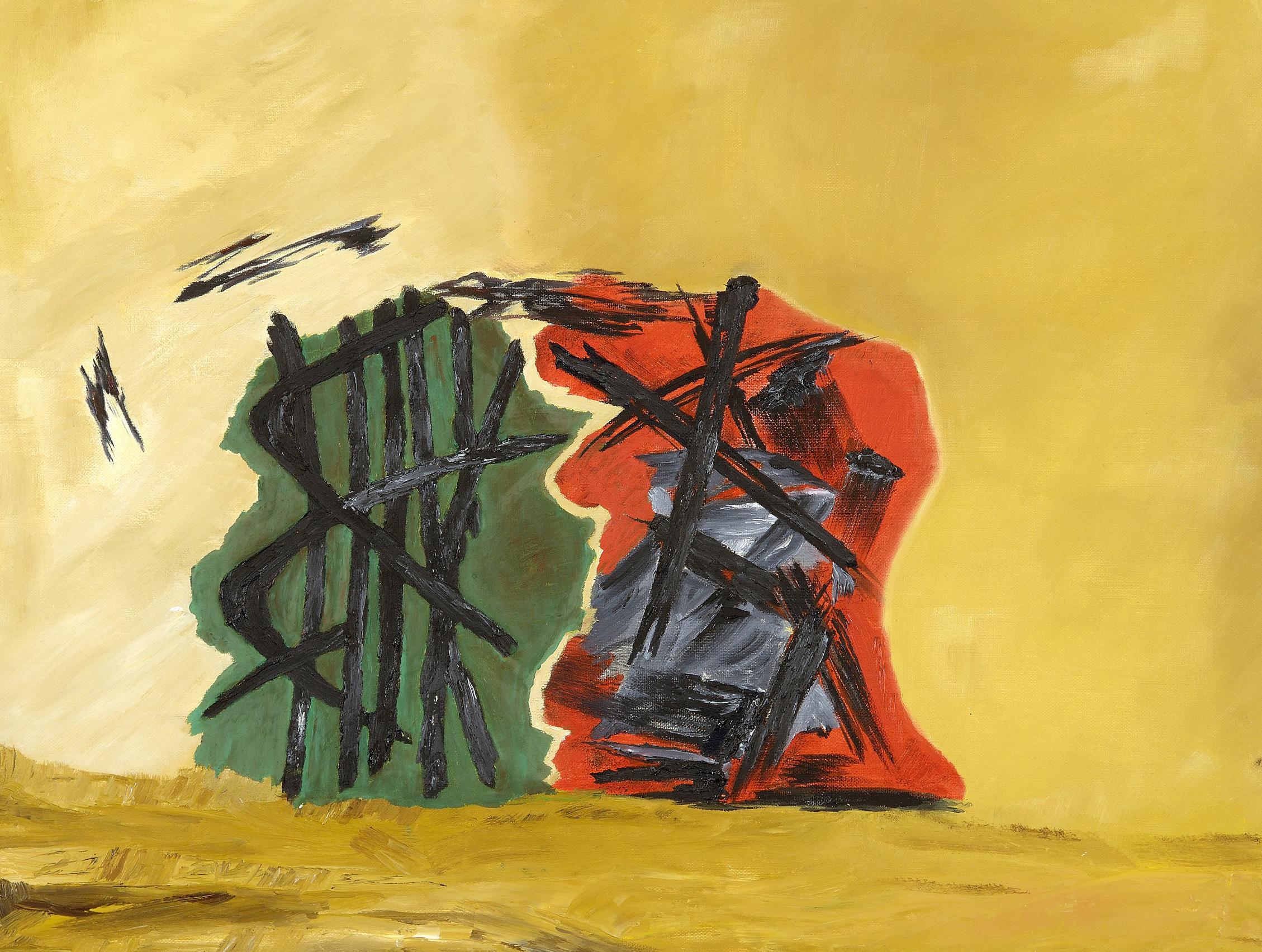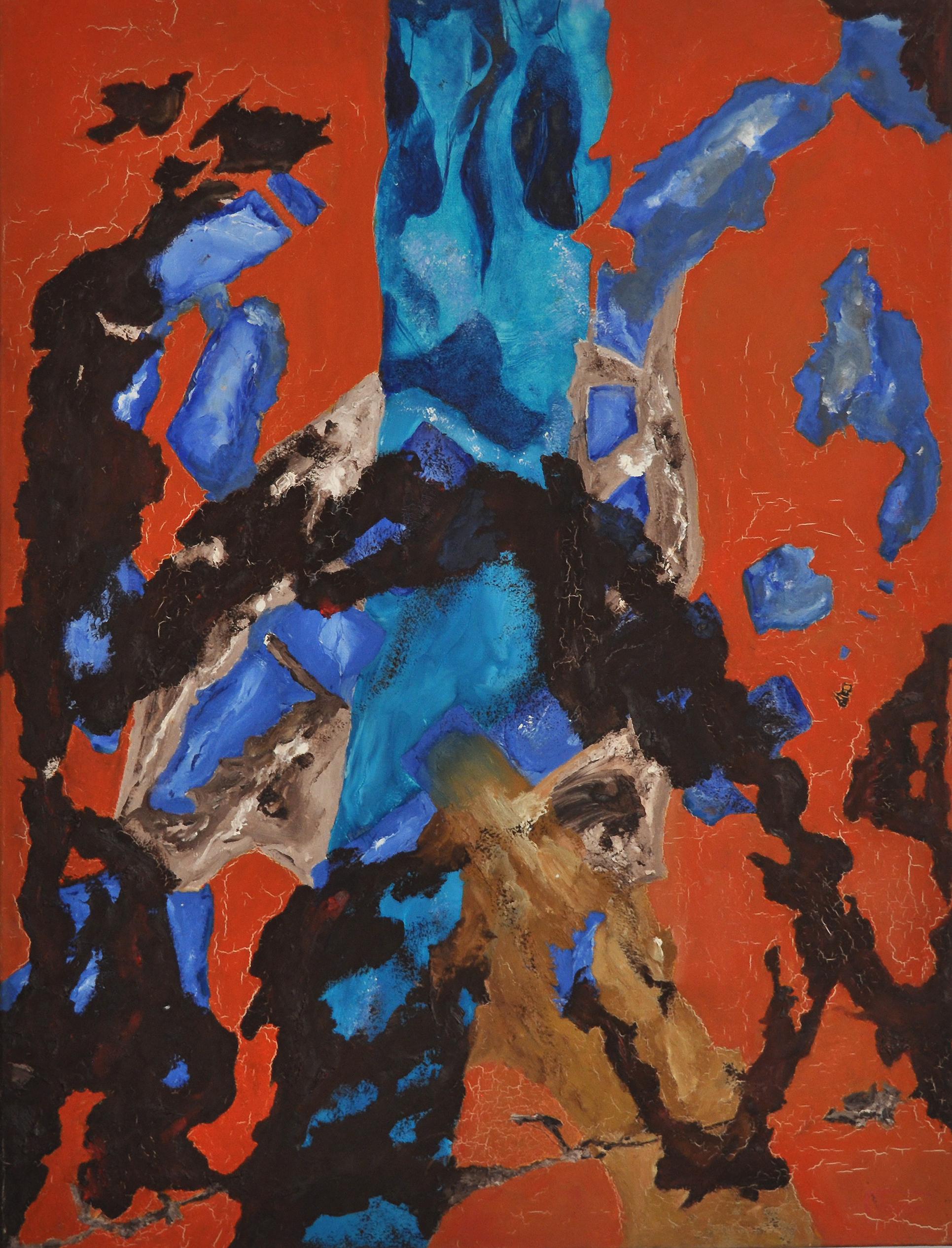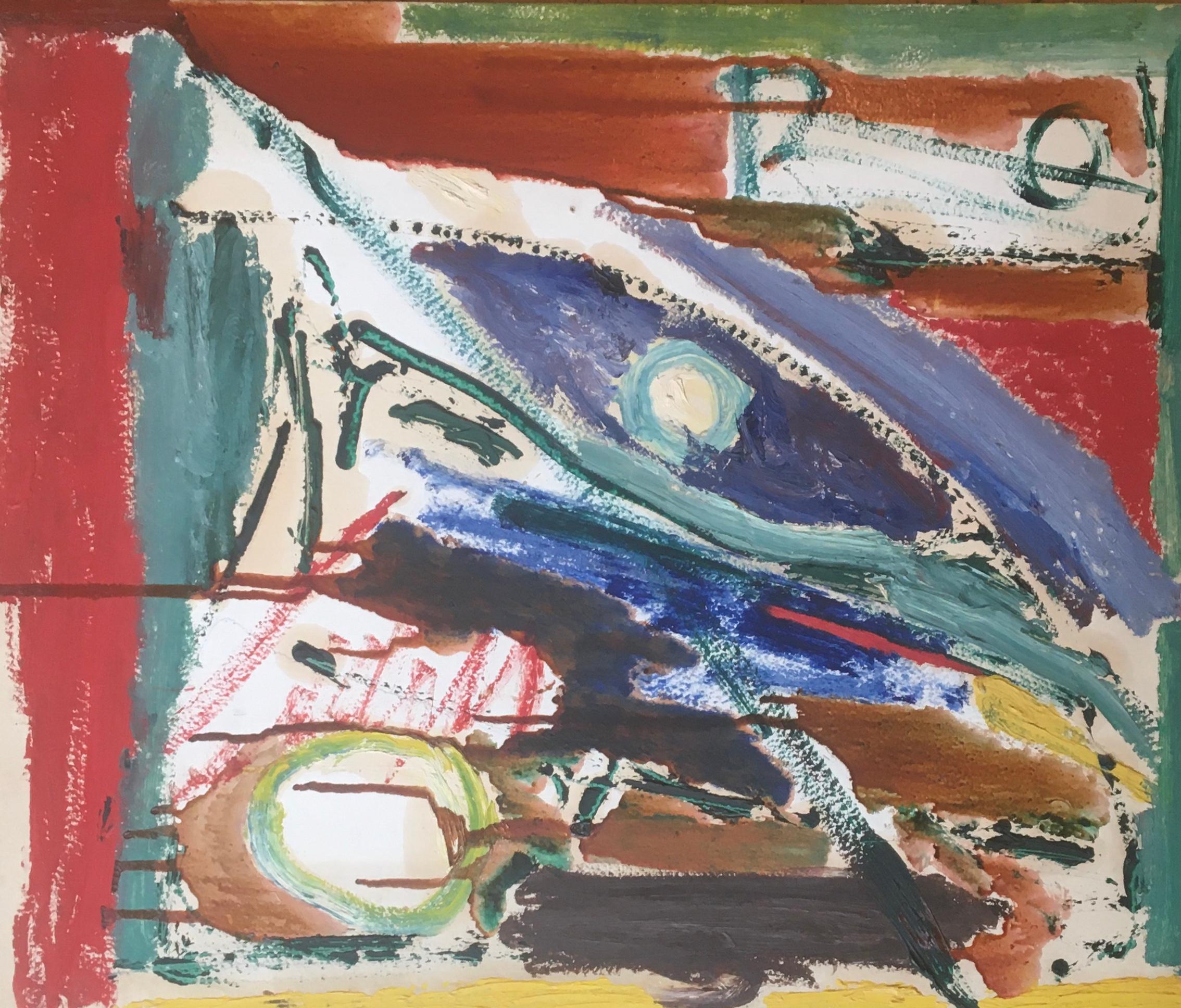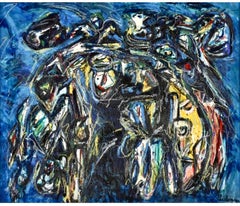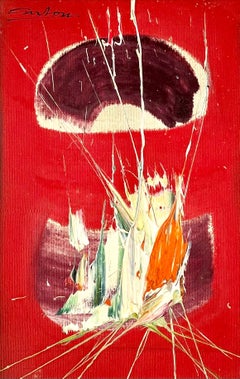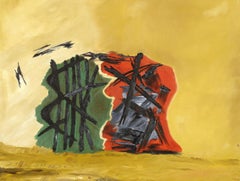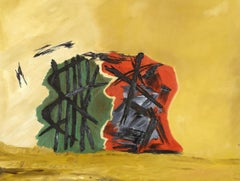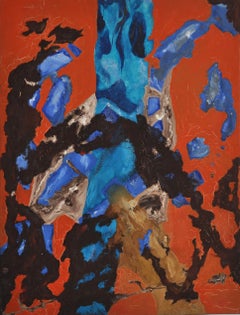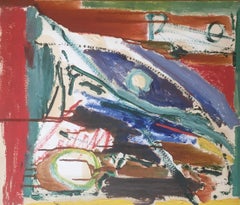Items Similar to Liberte, Egalite, Fraternite, Modernist Painting
Want more images or videos?
Request additional images or videos from the seller
1 of 6
Philippe VissonLiberte, Egalite, Fraternite, Modernist Painting1987
1987
$2,200
£1,661.85
€1,920.63
CA$3,091.59
A$3,437.31
CHF 1,809.95
MX$41,704.96
NOK 22,914.91
SEK 21,419.86
DKK 14,332.86
About the Item
Philippe Visson, (1942-2008), whose parents were both of Russian origin, was born in New York in 1942.
His mother, a Parisian art historian, was the Editor of La Gazette des Beaux-Arts from 1930 to 1960, and had always frequented the international artistic milieu. His father was a major political journalist for The Washington Post and Roving Editor for The Reader’s Digest. Philippe Visson therefore was raised in a cosmopolitan milieu between the United States and Europe. At the Vissons, one devours; one spends beyond one’s means; one falls, but only to land on one’s feet.
Visson is a painter to whom it is difficult to assign a particular movement in art history; and that, principally for two reasons: firstly, his origins,his education and his way of life have produced a personality without any true roots, but rather a citizen of the world, who carries with him all cultures, from pre-Revolutionary Russia to the black ghetto of Washington, D.C.
Secondly, he is self-taught, and can work in complete solitude, as well as before a large audience. His art is therefore uniquely his own, and certainly not that of an Art Brut ‘author’. His faces, his anti-portraits, reveal a continuum of humanity’s facets: from Christ to the demon, from the child to the aged, from the Caucasion to the African.
Biography
Philippe Visson, whose parents were both of Russian origin, was born in New York in 1942. His mother, a Parisian art historian, was the Editor of “The Gazette des Beaux-Arts” and had always frequented the international artistic milieu. His father was a major American political journalist for “The Washington Post” and “The Readers Digest”. Philippe Visson therefore was raised in a cosmopolitan milieu between the United States and Europe.
He starts to paint in the bathroom of Parisian luxury hotel at the age of 16, working in a frenzy and without art lessons. He’s immediately confronted with the scrutiny of professional experts that surround his parents. He has instant success when he shows at the Craven Gallery in Paris in December, 1958, quickly offered to him; then in New York in the Milch Galleries in May, 1959; followed by shows in Monte Carlo, Geneva and New York again. It was too much, too soon. Visson falls into drinking.
Returning to Washington, D.C. on 1960, the period 1963-1979 is differentiated by a life that is sometimes social, sometimes reclusive, which continues when his family settles in a large villa in Switzerland (Epalinges above Lausanne) in the mid-sixties. Visson has stopped drinking. He paints in one of the rooms of his parents’ house and inundates all the empty rooms with his productions that remain hidden from the public, allowing them to be seen only by personalities such as Marcel Brion and René Huyghe, both of the Académie Française; or Jean Leymarie, Director of the Museum of Modern Art in Paris.
It’s only at the start of the seventies that he once again opens his work to the public. He meets several important cultural figures of the time, such as René Berger, Director of the State Fine Arts Museum of Lausanne; and Michel Thévoz, future Director of the Art brut Museum.
After the death of his father in 1973, he settles without money with his mother in a luxury hotel in Paris. It’s only after a year and a half of perpetual and colorful adventures that they return to Washington, D.C., where he resumes painting and produces a unique period of abstracts.
Returning to Switzerland at the death of his mother in the beginning of the eighties, Visson meets with blatant success in Switzerland, where institutions exhibit and purchase his paintings (Aarau State Fine Arts Museum, the Federal Office of Culture in Bern). His fury for painting takes the form of an explosion while remaining focused (he always keeps what he considers the best paintings for himself).
After the life of a hermit in the Paccots, Visson comes down from his mountain to settle in Montreux on the Swiss Riveria. This moving is marked by a sort of return to social life, despite the fact that he paints in a cellar. A period of public projects with charitable goals is launched. Visson thrives on this contact with the public.
This changes somewhat when he receives a working studio in The Montreux Palace in the late nineties. This emerging from the cellars denotes a new era for the artist. He starts an intense period of painting, and moves six thousand of his paintings to the Palace. He continues his public projects, including the acquisition against paintings of a Stradivarius violin that will bear his name. He establishes his Visson Foundation to support the SVPA (Vaudoise Society for the Protection of Animals).
- Creator:Philippe Visson (1942, American)
- Creation Year:1987
- Dimensions:Height: 25.5 in (64.77 cm)Width: 12.25 in (31.12 cm)
- Medium:
- Movement & Style:
- Period:
- Condition:
- Gallery Location:Surfside, FL
- Reference Number:1stDibs: LU38211657522
About the Seller
4.9
Platinum Seller
Premium sellers with a 4.7+ rating and 24-hour response times
Established in 1995
1stDibs seller since 2014
1,793 sales on 1stDibs
Typical response time: <1 hour
- ShippingRetrieving quote...Shipping from: Surfside, FL
- Return Policy
Authenticity Guarantee
In the unlikely event there’s an issue with an item’s authenticity, contact us within 1 year for a full refund. DetailsMoney-Back Guarantee
If your item is not as described, is damaged in transit, or does not arrive, contact us within 7 days for a full refund. Details24-Hour Cancellation
You have a 24-hour grace period in which to reconsider your purchase, with no questions asked.Vetted Professional Sellers
Our world-class sellers must adhere to strict standards for service and quality, maintaining the integrity of our listings.Price-Match Guarantee
If you find that a seller listed the same item for a lower price elsewhere, we’ll match it.Trusted Global Delivery
Our best-in-class carrier network provides specialized shipping options worldwide, including custom delivery.More From This Seller
View AllLarge Abstract Expressionist Oil Painting on Canvas John Von Wicht WPA Artist
Located in Surfside, FL
John von Wicht (German American, 1888-1970)
"On Blue"
1964
Oil and acrylic on canvas
Hand signed lower right "V. Wicht",
Hand signed, titled, and dated on the stretcher "1964-66"
D...
Category
1960s Abstract Expressionist Abstract Paintings
Materials
Oil, Canvas, Acrylic
Large German Neo Figuarist Abstract Expressionist Oil Painting Werner Liebmann
Located in Surfside, FL
WERNER LIEBMANN (German b. 1951)
"Elf Köpfe Bei Nacht,"
Oil on canvas, signed L/R, "Liebmann;"
29 1/4'' x 35 1/2'', framed 31'' x 37''.
Werner Liebmann (born 1951) is a German painter and graphic artist .
Werner Liebmann was born in Königsthal in Thuringia. Born in Königsthal from 1969 to 1973 he studied chemistry at the Martin Luther University in Halle (Saale) . From 1973 to 1976 he worked as a project engineer. He was active as a chemist until he opted for an artistic career and studied painting at the University of Art and Design in Halle. A master student of Bernhard Heisig, he graduated at the College of Fine Arts Leipzig.
Since then, he has been a freelance artist, as well as a professor at the College of Fine Arts in Dresden and currently at the Art school Berlin – Weissensee. His works were represented at numerous group exhibitions and solo exhibitions in Halle, Hamburg, Berlin, Düsseldorf and further cities, mostly in Germany. Influenced by the Neo Figuraist artists of the Junge Wilde painters. In 1978, the Junge Wilde painting style arose in the German-speaking world in
opposition to established avant garde, minimal art and conceptual art. It was linked to the similar Transavanguardia movement in Italy, USA (neo-expressionism) and France (Figuration Libre). The Junge Wilde painted their expressive paintings in bright, intense colors and with quick, broad brushstrokes very much influenced by Professor at the Academy of Art in Berlin, Karl Horst Hödicke (b:1938). They were sometimes called the Neue Wilde. Berlin: Luciano Castelli, Rainer Fetting...
Category
Late 20th Century Neo-Expressionist Abstract Paintings
Materials
Canvas, Oil
American Vivid Abstract Expressionist Art Oil Painting Norman Carton, WPA Artist
By Norman Carton
Located in Surfside, FL
Norman Carton (1908 – 1980) was an American artist and educator known for abstract expressionist art. He was born in the Ukraine region of Imperial Russia and moved to the United States in 1922 where he spent most of his adult life.
A classically trained portrait and landscape artist, Carton also worked as a drafter, newspaper illustrator, muralist, theater set designer, photographer, and fabric designer and spent most of his mature life as an art educator. Carton showed in and continues to be shown in many solo and group exhibitions. His work is included in numerous museums and private collections throughout the world.
Norman Carton was born in the Dnieper Ukraine territory of the Russian Empire in 1908. Escaping the turbulence of civil war massacres, he settled in Philadelphia in 1922 after years of constant flight. While attending the Pennsylvania Museum School of Industrial Art, Carton worked as a newspaper artist for the Philadelphia Record from 1928 to 1930 in the company of other illustrator/artists who had founded the Ashcan School, the beginnings of modern American art. From 1930 to 1935, he studied at the Pennsylvania Academy of Fine Arts under Henry McCarter, who was a pupil of Toulouse-Lautrec, Puvis de Chavanne, and Thomas Eakins. Arthur Carles, especially with his sense of color, and the architect John Harbison also provided tutelage and inspiration. Following his time at the Pennsylvania Academy of Fine Arts, Carton studied at the Barnes Foundation from 1935 to 1936 where he was influenced by an intellectual climate led by visiting lecturers John Dewey and Bertrand Russell as well as daily access to Albert C. Barnes and his art collection.
Carton was awarded the Cresson Traveling Scholarship in 1934 which allowed him to travel through Europe and study in Paris. There he expanded his artistic horizons with influences stemming from Henri Matisse, Pablo Picasso, Chaim Soutine, and Wassily Kandinsky. While at the Pennsylvania Academy of Fine Arts, Carton was also awarded the Toppan Prize for figure painting as well as the Thouron Composition Prize. He received numerous commissions as a portrait artist, social realist, sculptor, and theatrical stage designer as well as academic scholarships. During this time, Carton worked as a scenery designer at Sparks Scenic Studios, a drafter at the Philadelphia Enameling Works, and a fine art lithographer.
From 1939 to 1942, the Works Progress Administration (WPA) Federal Art Project employed Carton as a muralist and easel artist. He collaborated with architect George Howe. The WPA commissioned Carton to paint major murals at the Helen Fleischer Vocational School for Girls in Philadelphia, the Officers’ Club at Camp Meade Army Base in Maryland, and in the city of Hidalgo, Mexico. Throughout the 1940s, Carton exhibited and won prizes for his semi-abstract Expressionist and Surrealist paintings. He socialized with and was inspired by Émile Gauguin and Fernand Leger. During World War II, Carton was a naval structural designer and draftsman at the Cramps Shipbuilding Corporation in Camden, New Jersey. Here, he created non-objective sculpture with metal. After the war, Carton co-founded a fabric design plant in Philadelphia. He produced hand-printed fabrics for interiors and fashion that were featured in Harper’s Bazaar, Vogue and Women’s Wear Daily. Original fabric designs were commissioned by notable clients including Lord & Taylor, Gimbels, and Nina Ricci. Some of these designs are at the Metropolitan Museum of Art. Carton traded his partnership in the fabric design company in 1949 to focus full-time on painting. Carton had his first solo exhibition in 1949 at the Philadelphia Art Alliance. This show was followed closely by solo exhibitions at the Laurel Gallery (New York City) and Dubin Gallery (Philadelphia). At this time, his exhibited work was Abstract impressionism. In addition to painting, he taught classes at the Philadelphia Museum of Art and was the Founder and first President of the Philadelphia chapter of Artist’s Equity Association. The Philadelphia Museum of Art and the organization of the National Museums of France commissioned Carton to travel to Europe, mainly France, in 1950 for a color photography study of continental masterpieces. He was granted access to study the restoration of the Mona Lisa and was one of the very few to be given permission to remove the painting from its frame. During his three year stay in Paris, he had solo exhibits at La Sorbonne and Gallery Rene Breteau and was in 15 group shows in Paris salons including Les Sur Independants, Salon d’Automne, and Realities Nouvelles. He also exhibited at the Musee d’Art Juif where he won the Prix d’Art. The Cercle Paul Valery twice sponsored Carton to present lectures at the Sorbonne. He conducted seminars at the Louvre for the Cercle Esthetique Internationale and taught classes in and directed stage and costume design for the Theatre de Recherche at the Paris Opera. Among his Paris artist colleagues were Chana Orloff, Earl Kerkam, Sam Francis, Claire Falkenstein, Lawrence...
Category
Mid-20th Century Abstract Expressionist Landscape Paintings
Materials
Canvas, Oil
French Surrealist Abstract Painting
By Georges Dussau
Located in Surfside, FL
Georges DUSSAU est né le 14 Mars 1947, à Chalon-sur-Saône (France)
Il vit et travaille à Mellecey (France) et à Mougins (France)
1962 - 1963 - 1964 - Ecole de dessin - Chalon-su...
Category
20th Century Surrealist Abstract Paintings
Materials
Canvas
Large Mod Abstract Expressionist Modernist Edward Avedisian Color Field Painting
By Edward Avedisian
Located in Surfside, FL
Edward Avedisian (American, 1936-2007)
Abstract Large Painting
Acrylic on panel heavily textured with a 3D effect.
Dimensions: 48"h x 75"w
Circa late 1970s, early 1980s
Provenance: ...
Category
1970s Abstract Expressionist Abstract Paintings
Materials
Acrylic, Wood Panel
Large Mod Abstract Expressionist Modernist Edward Avedisian Color Field Painting
By Edward Avedisian
Located in Surfside, FL
Edward Avedisian (American, 1936-2007)
Abstract Large Painting
Acrylic on panel heavily textured with a 3D effect.
Dimensions: 48"h x 75"w
Circa late 1970s, early 1980s
Provenance: ...
Category
1970s Abstract Expressionist Abstract Paintings
Materials
Acrylic, Wood Panel
You May Also Like
French Contemporary Art by Francis Moreau - Passant Parmi... 2
Located in Paris, IDF
Oil on canvas
Francis Moreau is a French artist (1940-2021) who lived and worked in Paris, France. Like many others, he wasn't born with a brush from childhood but through hard wor...
Category
2010s Contemporary Abstract Paintings
Materials
Canvas, Oil
French Contemporary Art by Francis Moreau - Passant Parmi les Paroles Passagères
Located in Paris, IDF
Oil on canvas
Francis Moreau is a French artist (1940-2021) who lived and worked in Paris, France. Like many others, he wasn't born with a brush from childhood but through hard wor...
Category
2010s Contemporary Abstract Paintings
Materials
Canvas, Oil
French Contemporary Art by Francis Moreau - Hypostase
Located in Paris, IDF
Oil on canvas
Francis Moreau is a French artist (1940-2021) who lived and worked in Paris, France. Like many others, he wasn't born with a brush from childhood but through hard wor...
Category
2010s Contemporary Abstract Paintings
Materials
Canvas, Oil
Abstract composition
Located in Genève, GE
Work on canvas
Category
Late 20th Century French School Abstract Paintings
Materials
Gouache
French Contemporary Art by Francis Moreau - Lorelei
Located in Paris, IDF
Oil on canvas
Francis Moreau is a French artist (1940-2021) who lived and worked in Paris, France. Like many others, he wasn't born with a brush from childhood but through hard wor...
Category
2010s Contemporary Abstract Paintings
Materials
Canvas, Oil
French Contemporary Art by Francis Moreau - Fuite météorique 2
Located in Paris, IDF
Oil on canvas
Francis Moreau is a French artist (1940-2021) who lived and worked in Paris, France. Like many others, he wasn't born with a brush from childhood but through hard wor...
Category
2010s Contemporary Abstract Paintings
Materials
Canvas, Oil
More Ways To Browse
Geneva Painting
Vintage Bear Painting
Black Bear Paintings
Society Of Six Painting
Monte Carlo Painting
Violin Painting
Vintage Bathroom Painting
20th C Russian Paintings
Demon Painting
Mother Child Africa
Jean Liberte
Liberte Egalite Fraternite
Stradivarius Violin
Paintings Of Shells
Fragment Oil Painting
Pair Of Abstract Paintings
Rose De France
Spirit Of Freedom
